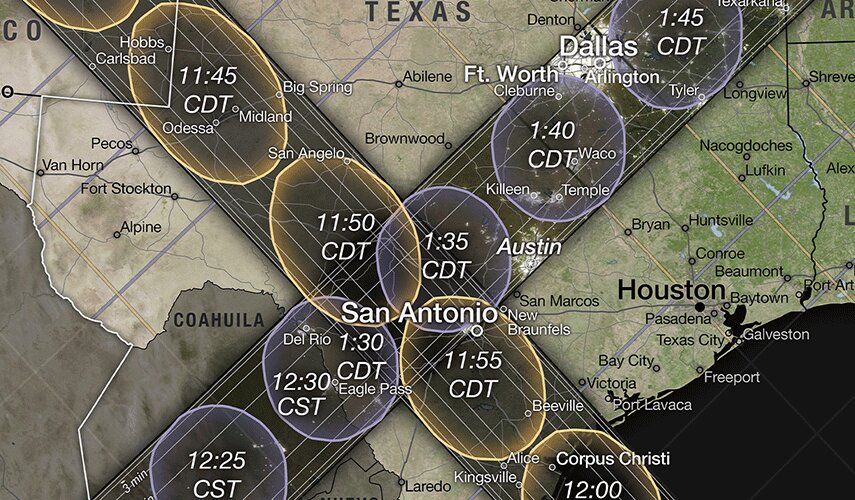Annular eclipse comes to Texas this Saturday
The first of two solar eclipses that will darken skies and obscure the sun over the Lone Star State will take place this Saturday, Oct. 14.
Gonzales County will be able to witness the partial eclipse, but will not be along the path of annularity — the narrow strip of land where the eclipse can be seen in its entirety and during which the sun pokes out behind the moon like a ring of fire.
However, there are locations not far away that will fall within that path of the annular eclipse where one can experience a phenomenon that only takes place on average once in about every 375 in any given location, according to Angela Speck, professor and chair of the UTSA Department of Physics and Astronomy.
“It's hard to convey just how amazing it is to experience an eclipse,” Speck said. “One thing is that it’s not just visual. Obviously, it’s gorgeous to look at but you also feel it on your skin because it cools down and you get a breeze. There’s also sounds depending on where you are. Right before a total eclipse, the birds get loud and then when it goes dark, they are quiet. For me, it’s not just one thing. You have all this stuff going on all at once and you have a very limited time to take everything in. It’s kind of very intense.”
Neighboring Seguin in Guadalupe County will be within the path of annularity, which will begin there at 11:54:37 a.m. and last for just 41 seconds. In Comal County, New Braunfels will see annularity at 11:54:02 a.m. but it will be over in just 59 seconds at 11:55:01 a.m.
For a longer view of the eclipse, you can go to Three Rivers, where annularity begins at 11:53:36 a.m. and goes for five minutes and one second — the longest viewing time short of driving to Corpus Christi, where annularity begins at 11:55:48 a.m. goes for five minutes and two seconds.
There’s George West, where annularity will commence at 11:53:54 a.m. and continue for five full minutes — one of the longest viewing times available. In Pleasanton, annularity begins at 11:52:27 a.m. and continues for four minutes, 58 seconds, while in Beeville, annularity begins at 11:54:26 a.m. and continues for four minutes, 54 seconds.
Karnes City will see annularity begin at 11:53:56 a.m. and end four minutes, 22 seconds later, while Kenedy will see it begin at 11:53:56 a.m. and end four minutes, 25 seconds later. In Goliad, there will be three minutes, 35 seconds of annularity beginning at 11:55:18 a.m.
“With any type of solar eclipse, you get a partial eclipse. By that I mean part of the sun is visible and part of the sun is hidden. Depending on where you are, you may get the moon directly between us and the sun. That’s what we’re going to see here,” said Speck.
“In the case of an annular eclipse, you’re going to see a partial eclipse until the moon is directly in the way. It’s still technically a partial eclipse because we can see part of the sun. We see the edge of the sun all the way around the moon. That’s the annular eclipse because annulus is a fancy word for donut. It takes about an hour and a half for the partial phase and then, for maybe four minutes or so, it’s in annularity, where we see a ring of fire. Then you have another hour and a half of partial.”
Speck reminded people they will need special lenses to view the eclipse to protect their eyes.
“I think this is one of those things where you can have people go out and they don’t need any special equipment,” Speck said. “It’s good to have the special lenses so you don’t hurt your eyes, but even if you don’t have them, you can experience an eclipse. It doesn’t cost you anything.
“If we want to view the sun, even on a normal day, we shouldn't be staring at it. But you can use a projection effect to experience an eclipse. It's basically what a pinhole camera is, but anything that has a hole in it is going to work. If you have a colander, like a pasta drainer, you can hold it and look at the shadow on the ground to experience the images of the sun throughout the eclipse.
“Anything with holes will work, and it doesn’t matter what shape the holes are either. In fact, one of the coolest things is to find a tree. Stand by the tree and look at the shadow underneath because all of the little gaps between the leaves behave like holes. So, you get lots and lots of images of the sun. This happens every day but on a normal day, all those images are circular, which is kind of boring. But on an eclipse day, you have lots of little presences of the sun.”
Comments






